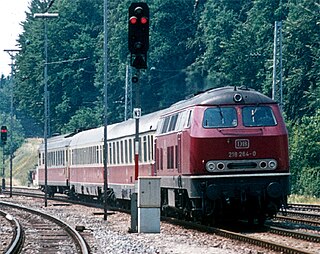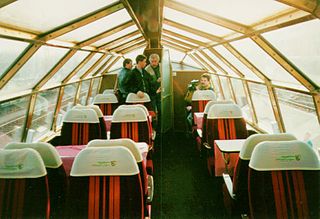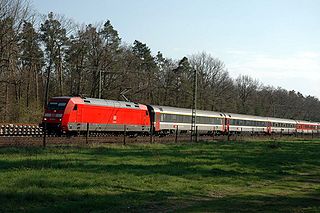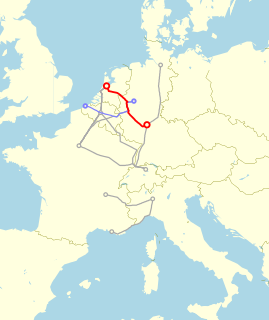 W
WThe Albert Schweitzer was a short-lived express train that linked Dortmund Hbf in Dortmund, Germany, with Strasbourg-Ville in Strasbourg, France. Introduced in 1980, it was operated by the Deutsche Bundesbahn (DB) and the SNCF.
 W
WThe Bavaria was an express train that linked München Hbf in Munich, Germany, with Zürich HB in Zurich, Switzerland. Introduced in the 1950s, it ran through to Geneva until 1969, when it was cut back to Zurich. The train was named on the basis that Bavaria is the Latin equivalent to the German word Bayern, the official name of the federal state of Bavaria, of which Munich is the capital. It was operated by the Deutsche Bundesbahn / Deutsche Bahn (DB) and the Swiss Federal Railways (SBB-CFF-FFS). The route also included a single stop in Austria, at Bregenz. The 24 km (15 mi) section between Lindau, Germany, and St. Margrethen, Switzerland, is located mostly in Austria, but Swiss locomotives hauled the train over this section, most of which is part of the Vorarlberg line of Austrian Federal Railways.
 W
WThe Berlin-Warszawa-Express (BWE) is a cross-border train service that connects Berlin and Warsaw via Frankfurt (Oder), operated jointly by Deutsche Bahn and Polish State Railways. The service, classed as EuroCity, runs four times per day in each direction, with the services given the numbers 40–47. Total journey time is 5 hours, 24 minutes.
 W
WBerolina was a named passenger train between Warsaw and Berlin via Frankfurt (Oder). Introduced in 1959, it went through a number of iterations, including a short period without a name. Part of the Interexpress network as IEx 242/243 from 1986, it became categorised as EuroCity trains 42 and 43 in 1992. The service was finally replaced by the Berlin-Warszawa-Express in 2002.
 W
WThe Blauer Enzian is a named express train service that currently runs between Frankfurt in Germany and Klagenfurt in Austria. Introduced in 1951, it originally ran via the German North–South railway line between Hamburg and Munich. Labelled as an international Trans Europ Express (TEE) train, it also linked with Zell am See and Klagenfurt in Austria from 1969. Trains were operated by the Deutsche Bundesbahn (DB) and its Deutsche Bahn successor, from 1970 also by the Austrian Federal Railways (ÖBB).
 W
WThe Colosseum was an express train initially linking Rome and Milan, later Frankfurt am Main. The train was named after the Amphitheatrum Flavium, renowned as the Colosseum.
 W
WThe Erasmus was an express train that linked The Hague, the Dutch seat of Government, with Munich in Germany. The train was named after the Dutch Renaissance humanist Desiderius Erasmus.
 W
WThe Gambrinus was an express train in Germany, initially linking Munich and Kiel. The train was named after the God of Beer Gambrinus.
 W
WThe Goethe was an express train that, for most of its existence, linked Paris-Est in Paris, France, with Frankfurt Hbf in Frankfurt, Germany. Introduced in 1970, it was operated by the SNCF and the Deutsche Bundesbahn / Deutsche Bahn (DB).
 W
WThe Helvetia was an express train that, for most of its existence, linked Hamburg-Altona station in Hamburg, Germany, with Zürich HB in Zurich, Switzerland. Introduced in 1952, it was operated by the Deutsche Bundesbahn / Deutsche Bahn (DB) and the Swiss Federal Railways (SBB-CFF-FFS). The train's name, Helvetia, is the Latin word for "Switzerland".
 W
WHungaria is a EuroCity train which runs between Budapest Nyugati and Hamburg - Altona, currently running with coaches of MÁV. It is numbered as EC 172-173 and runs daily, mainly with MÁV owned rolling stocks.
 W
WThe Karwendel is an international named express train service between Germany and Austria. The train was named after the Karwendel mountain range forming the German-Austrian border south of Garmisch-Partenkirchen, which it passes on the Mittenwald Railway (Karwendelbahn). Introduced in 1930, it is currently labelled as an Intercity-Express train connection operated by Deutsche Bahn AG.
 W
WThe Komet was an international overnight express train service between Germany and Switzerland, which was in operation from 1954 to 2016. Its name reflected the notion that the Comet train and an actual comet can both be described as travelling through the night at high speed. It was introduced in 1954. It became a EuroCity (EC) service upon the launch of the EC network in 1987. It became categorised as CityNightLine (CNL) service in the mid-1990s. With the decision by Deutsche Bahn to terminate all CNL services in December 2016, the Komet ran for the last time on 10–11 December 2016.
 W
WThe Lufthansa Airport Express was an express train service in Germany, initially linking Düsseldorf and Frankfurt am Main Flughafen, and later Stuttgart too. The trains were operated by Deutsche Bundesbahn on behalf of the German airline Lufthansa, and with the airline providing the on-board customer service staff, and its use was limited to Lufthansa customers taking airplane flights into or out of Frankfurt or Düsseldorf airports.
 W
WThe word Mediolanum has been used to name three distinct international express trains that have run to and from Milano Centrale in Milan, Italy since 1957. The focus of these trains on the city now known as Milan reflects the fact that Mediolanum is the Latin word for ancient Milan.
 W
WThe Merkur was an international express train linking Copenhagen, the Danish capital, with Germany. The train was named after the Roman God Mercury, the God of traders and travellers.
 W
WThe Metropolitan was a premium passenger train service between the cities of Cologne and Hamburg in Germany. Meant as an alternative to air transport, the first-class-only trains were operated from 1 August 1999 until 11 December 2004 by Metropolitan Express Train GmbH (MET) based in Bad Homburg, a wholly owned subsidiary of the DB Fernverkehr AG wholly owned subsidiary of Deutsche Bahn AG. Service was discontinued in December 2004 due to low usage and profitability; the custom made coaches are since then deployed in Intercity traffic.
 W
WThe Molière was an international train operated by SNCF, initially linking Paris and Düsseldorf. The train was named after Jean Baptiste Poquelin, using his stage name.
 W
WThe Paris–Ruhr was an express train that linked Paris in France, with Dortmund in Germany. The train was named after its two termini, Paris in the west and the Ruhr district in the east. For most of its life, it was a Trans Europ Express (TEE).
 W
WThe Parsifal was an express train that linked Paris with Dortmund in Germany and later Cologne. The train was named after Wagner's opera inspired by the legendary knight Percival.
 W
WThe Prinz Eugen was an express train that linked northern Germany with Wien Westbf in Vienna, Austria. Introduced in 1971, it was operated by the Deutsche Bundesbahn / Deutsche Bahn (DB) and the Austrian Federal Railways (ÖBB).
 W
WRätia is a EuroCity train service that linked Hamburg in Germany with Chur in Switzerland via Dortmund, Cologne, Mannheim, Basel and Zurich, following the river Rhine for a significant part of its journey. The service is named after Rhaetia, the Roman province that the city of Chur was in. Over the years, the name Rätia has been given to a number EC services between Chur and various parts in Germany, although the current services - EC 6/7 - lost their name in 2004. Since 2015 the service's southern terminus was cut bach to Zurich.
 W
WThe Rembrandt was an express train that linked Amsterdam in the Netherlands, with Munich in Germany and later Chur in Switzerland. The train was named after the renowned Dutch painter Rembrandt. For its first 16 years it was a first-class-only Trans Europ Express, becoming a two-class InterCity in 1983 and finally a EuroCity in 1987.
 W
WThe Rhein–Main was an express train that linked Frankfurt am Main with Dortmund in Germany and later with Amsterdam in the Netherlands. The train was named after the two rivers, the Rhine and the Main, that join west of Frankfurt. For most of its life, it was a Trans Europ Express (TEE).
 W
WThe Rheingold ('Rhinegold') was a named train that operated between Hook of Holland, near Rotterdam, and Geneva, Switzerland, a distance of 1,067 kilometres (663 mi), until 1987. Another section of the train started in Amsterdam and was coupled to the Hoek cars in Utrecht. The Rheingold ran along the Rhine River via Arnhem, Netherlands, and Cologne, Germany, using special luxury coaches. It was named after Richard Wagner's Das Rheingold opera, which romanticized the Rhine. From 1965 until the train's discontinuation in 1987, the Rheingold was a first-class-only Trans Europ Express (TEE) train.
 W
WThe word Rheinpfeil was used to name a number of express trains that ran in Germany between the 1950s and 1991. For much of that period, a train carrying the name Rheinpfeil also linked Germany with at least one neighbouring country.
 W
WThe Roland was an express train that ran in Germany. For part of its existence, it was also an international train. Introduced in 1939, suspended during World War II, and reintroduced in 1952, it was operated in Germany by the Deutsche Reichsbahn Gesellschaft (DRG), the Deutsche Bundesbahn (DB) and the Deutsche Bahn (DB), respectively.
 W
WThe Saphir was an express train operated by the Deutsche Bundesbahn linking the port of Ostend with Dortmund as part of a link between London and the Ruhr. The name Saphir, German for sapphire, refers to the Belgian gemstone industry.
 W
WSibirjak was a passenger train which linked Berlin to some of main routes and cities of Russia. The train passed through Germany, Poland, Belarus, Russia and Kazakhstan, partly traveling on the Trans-Siberian Railway. With 5,130 km from Berlin to Novosibirsk it was the longest route of any that depart from a station within the European Union. The train service was discontinued with effect from 14 December 2013, due to lack of demand. The line was not actively promoted to potential customers by the Deutsche Bahn, but it was available in their search engine.
 W
WThe Van Beethoven was an international train linking the Dutch capital Amsterdam and the West German capital Bonn. The train was named after the Bonn-born composer Ludwig van Beethoven.
 W
WVarsovia, the New Latin word for Warsaw, Poland, has been the name of two distinct EuroCity international express trains, each of them originating and terminating in Warsaw.
 W
WThe Vindobona is an international named passenger train which began service in 1957 between Berlin and Vienna via Dresden and Prague. In later years the route was extended to run from Hamburg via Berlin, Dresden, Prague, Brno and Vienna to Villach. It was named after the ancient settlement of Vindobona on the site of the modern city of Vienna. Labelled as a EuroCity train connection from 1993, services discontinued in 2014.
 W
WWawel was a named international express train. Introduced in 1995 as an InterCity service, it was uplifted to EuroCity category by its operators PKP Intercity and DB Fernverkehr in 2006. The service was withdrawn at the end of 2014 and reintroduced in December 2020.